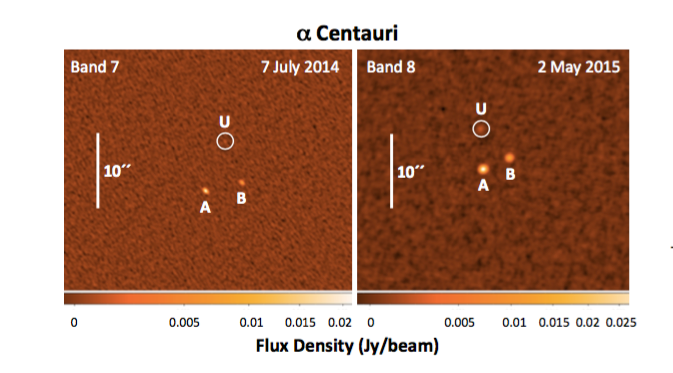
ALMA prototype-antennas at the ALMA test facility. Credit: ESO
2 separate teams of researchers (one from Mexico, the other Sweden), have incited skepticism among the astronomy community by posting papers on the preprint server arXiv each describing a different large object they observed in the outer edges of the solar system. Both teams made their observations after reviewing data from ALMA—a cluster of radio dishes in the Chilean mountains.

The two ALMA detections on March 20 and April 14, 2014. (Credit: V. H. T. Vlemmings et al., 2015)
One of the objects was found to be near W Aquilae in the night sky—the other adjacent to Alpha Centauri . Both groups report being skeptical at first regarding a faint glow but to their surprise they found that the objects appeared to move relative to the stars behind them, which suggested they might be relatively close and that they might be orbiting the sun. Both teams suggest there was enough data to allow for ruling out the object being an ordinary star.

Observations of the “Alpha Cen” object, designated “U”. (Credit: R. Liseau et al., 2015)
The Swedish team nick-named it Gna, after a Nordic God known for its swiftness, and have told the press they had no intention of suggesting they had found the mythical Planet X which supposedly lies somewhere beyond Pluto. Instead they suggest it might be a large asteroid. The team from Mexico went a little further suggesting that the object they observed might possibly turn out to be a brown dwarf.
There is also the possibility that either or both of the objects are merely illusions, random blips or noise that for a moment or two appeared to take the shape of a very far away object. Some have even tweeted their opinions, insinuating that jumping on the Planet X bandwagon would be sheer folly. Despite the skepticism, it is likely that other research groups will be training their instruments on the piece of sky where the objects were possibly seen, to prove or disprove their existence and to put a stop to the conjecture. Both of the teams involved have voiced their support of such efforts, noting that they would like an explanation for what they observed.
http://arxiv.org/abs/1512.02652 http://gizmodo.com/could-there-be-massive-planets-in-the-far-reaches-of-ou-1747410400 http://phys.org/news/2015-12-discovery-large-outer-edges-solar.htmljCp







Recent Comments